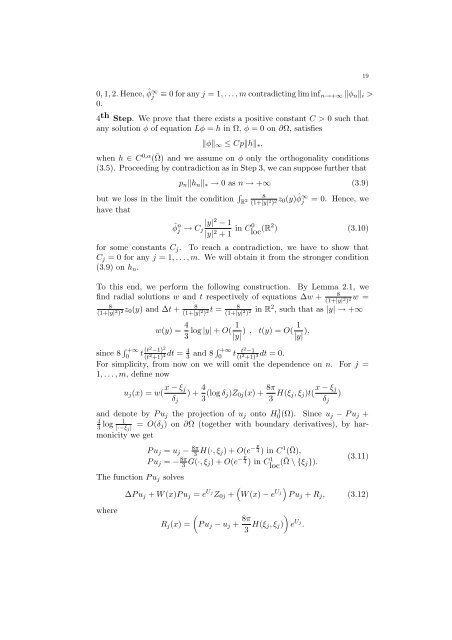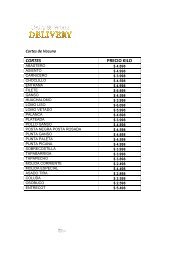CONCENTRATING SOLUTIONS FOR A PLANAR ... - CAPDE
CONCENTRATING SOLUTIONS FOR A PLANAR ... - CAPDE
CONCENTRATING SOLUTIONS FOR A PLANAR ... - CAPDE
You also want an ePaper? Increase the reach of your titles
YUMPU automatically turns print PDFs into web optimized ePapers that Google loves.
0, 1, 2. Hence, ˆφ ∞ j ≡ 0 for any j = 1, . . . , m contradicting lim inf n→+∞ ‖φ n ‖ i ><br />
0.<br />
4 th Step. We prove that there exists a positive constant C > 0 such that<br />
any solution φ of equation Lφ = h in Ω, φ = 0 on ∂Ω, satisfies<br />
‖φ‖ ∞ ≤ Cp‖h‖ ∗ ,<br />
when h ∈ C 0,α (¯Ω) and we assume on φ only the orthogonality conditions<br />
(3.5). Proceeding by contradiction as in Step 3, we can suppose further that<br />
p n ‖h n ‖ ∗ → 0 as n → +∞ (3.9)<br />
but we loss in the limit the condition ∫ 8<br />
R 2 z<br />
(1+|y| 2 ) 2 0 (y) ˆφ ∞ j<br />
have that<br />
19<br />
= 0. Hence, we<br />
ˆφ n j → C j<br />
|y| 2 − 1<br />
|y| 2 + 1 in C0 loc (R2 ) (3.10)<br />
for some constants C j . To reach a contradiction, we have to show that<br />
C j = 0 for any j = 1, . . . , m. We will obtain it from the stronger condition<br />
(3.9) on h n .<br />
To this end, we perform the following construction. By Lemma 2.1, we<br />
8<br />
find radial solutions w and t respectively of equations ∆w + w =<br />
(1+|y| 2 ) 2<br />
8<br />
8<br />
8<br />
z<br />
(1+|y| 2 ) 2 0 (y) and ∆t + t = in R<br />
(1+|y| 2 ) 2 (1+|y| 2 ) 2 , such that as |y| → +∞<br />
2<br />
w(y) = 4 3<br />
1<br />
1<br />
log |y| + O( ) , t(y) = O(<br />
|y| |y| ),<br />
since 8 ∫ +∞<br />
0<br />
t (t2 −1) 2<br />
dt = 4 (t 2 +1) 4 3 and 8 ∫ +∞<br />
0<br />
t t2 −1<br />
dt = 0.<br />
(t 2 +1) 3<br />
For simplicity, from now on we will omit the dependence on n. For j =<br />
1, . . . , m, define now<br />
u j (x) = w( x − ξ j<br />
) + 4 δ j 3 (log δ j)Z 0j (x) + 8π 3 H(ξ j, ξ j )t( x − ξ j<br />
)<br />
δ j<br />
and denote by P u j the projection of u j onto H0 1(Ω). Since u j − P u j +<br />
4<br />
3 log 1<br />
|·−ξ j |<br />
= O(δ j ) on ∂Ω (together with boundary derivatives), by harmonicity<br />
we get<br />
The function P u j solves<br />
P u j = u j − 8π 3 H(·, ξ j) + O(e − p 4 ) in C 1 (¯Ω),<br />
P u j = − 8π 3 G(·, ξ j) + O(e − p 4 ) in C 1 loc (¯Ω \ {ξ j }).<br />
∆P u j + W (x)P u j = e U j<br />
Z 0j +<br />
(3.11)<br />
(<br />
)<br />
W (x) − e U j<br />
P u j + R j , (3.12)<br />
where<br />
R j (x) =<br />
(<br />
P u j − u j + 8π )<br />
3 H(ξ j, ξ j ) e U j<br />
.





